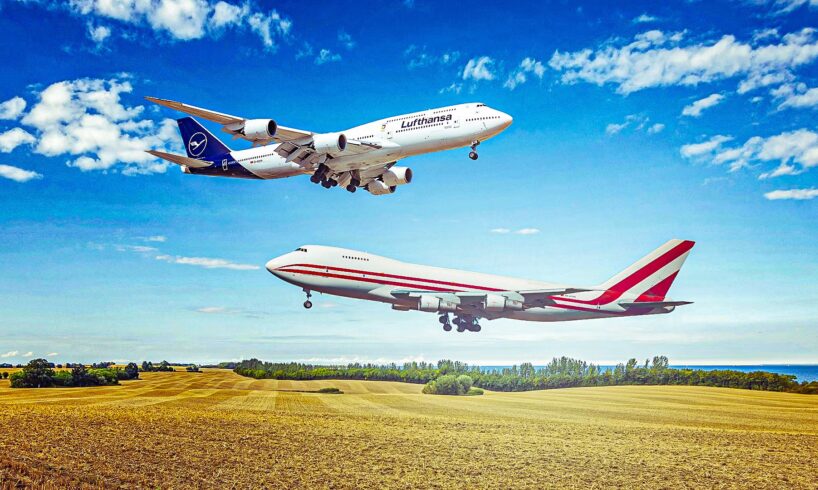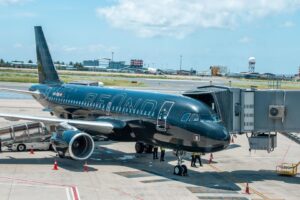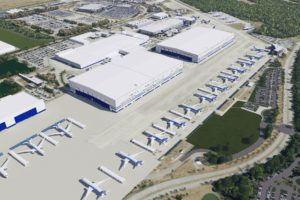
Few aircraft have captured the imagination of travelers and aviation fans like the Boeing 747. Dubbed the “Queen of the Skies,” the 747 transformed long-haul travel when it entered service in 1970, offering unprecedented range, capacity, and comfort. Its distinctive hump and upper deck lounge made it not just a workhorse for airlines but a cultural icon. Over the decades, Boeing refined the design through multiple generations, with the 747-100, 200, 300, and most famously the 747-400, which became the backbone of many intercontinental fleets.
By the early 2000s, however, airlines were facing new economic pressures: higher fuel costs, noise restrictions, and competition from efficient twin-engine widebodies like the Boeing 777 and Airbus A330. Boeing’s response was the 747-8, a stretched and modernized version that borrowed heavily from the cutting-edge 787 program. While it offered improved performance and lower costs per seat, the 747-8 was also the swan song of the jumbo jet era. To understand why, it’s worth comparing the “classic” 747s to the 747-8 in terms of design, performance, and legacy.
From Classic to Modern: The Evolution of the 747
Credit:
Wikimedia Commons
The “classic” Boeing 747s, typically referring to the -100, -200, and -300 series, cemented the aircraft’s reputation as the dominant long-haul airliner from the 1970s through the early 1990s. These early models were defined by their four engines, extended fuselage, and a distinctive partial upper deck that originally featured a passenger lounge before most airlines converted the space into additional seating. The 747-400, introduced in 1989, further advanced the design with modern avionics, winglets, and improved fuel efficiency, becoming the most widely produced and recognizable variant.
By the time the Boeing 747-400 was in full operation, however, aviation technology was already advancing. Airlines sought aircraft that could fly longer routes with fewer engines, paving the way for the rise of large twin-engine jets. Boeing knew the 747 line could not remain competitive without modernization. The company explored multiple advanced versions, but it was the 747-8, launched in 2005, that became a reality.
The 747-8 represented both continuity and change. Externally, it retained the familiar hump-backed silhouette, but inside and under the skin, it was a far more advanced machine. It integrated next-generation engines, a redesigned wing, and a stretched fuselage. In doing so, Boeing attempted to preserve the heritage of the 747 while addressing the demands of a new century.
Cockpit, Systems, and Commonality
Credit: Boeing
One major difference lies in the flight deck and onboard systems. The 747-200 used traditional analogue gauges and required a three-person crew, including a flight engineer. By contrast, the 747-8 features a modern glass cockpit with advanced avionics, allowing operation with only two pilots. This design update also reduced training and transition costs for airlines by aligning with contemporary cockpit standards.
Boeing introduced partial fly-by-wire functionality on the 747-8, applied mainly to the spoilers and lateral control systems. While not a fully fly-by-wire aircraft like newer models, these enhancements improved handling precision and lowered pilot workload. The flight management system was also upgraded, incorporating advanced software refinements from later Boeing designs.
.
From a maintenance and operations perspective, Boeing designed the 747-8 to remain largely compatible with existing ground-support infrastructure, allowing airlines to operate the aircraft without major changes to their facilities. However, its increased wingspan of 224 feet 7 inches (68.4 meters) compared to earlier 747 models can require special accommodations at certain airports, which limited its appeal for some carriers.
Stretching the Frame: Size and Capacity Differences
Credit: Wikimedia Commons
One of the most obvious differences between the 747-8 is its size. The aircraft is stretched compared to earlier 747 models, to around 250 feet 2 inches (76.25m), making it the longest passenger aircraft in the world at the time of its debut. This extra length allows for more seating capacity and significantly greater cargo volume in the freighter version.
For passengers, the stretch gives airlines flexibility to configure cabins in multiple layouts, often accommodating 450-467 passengers in a typical three-class arrangement. Cargo operators benefit from the increased volume, as the 747-8F can carry more pallets than previous 747 freighter models. This combination of passenger and cargo capacity made the aircraft especially attractive in markets where size and payload were critical.
However, the added length also introduced challenges. A longer fuselage can affect handling, particularly during ground operations, taxiing, and rotation on takeoff. Boeing had to carefully balance structural weight and performance to ensure the 747-8 maintained predictable handling characteristics. While successful in this regard, the aircraft’s stretch made it less versatile at certain airports compared to earlier 747 models.
New Wings and New Engines: Aerodynamic Advances
Credit: Shutterstock
The 747-8’s most significant innovation was its wing. While the original variants, such as the 747-200, had a conventional wing and the 747-400 added simple winglets, the 747-8 features a higher-aspect-ratio wing with raked wingtips, similar to the 787. This design increases lift, reduces drag, and improves long-range efficiency, with advanced materials and a new flap system further enhancing performance.
Equally important are the engines. The 747-8 uses General Electric GEnx-2B67, derived from the 787, with a larger bypass ratio, composite fan blades, and chevron nozzles. These provide quieter, cleaner, and more fuel-efficient operation compared with the older engines of the 747-200 and 747-400, while reducing noise at airports. Compared to the original 747, these wing and engine upgrades represent the most substantial aerodynamic and propulsion improvements in the jumbo’s history.
Specification (Data from Boeing-747.com and Boeing)
Boeing 747-200B
Boeing 747-8 Intercontinental
Engine Models
– Pratt & Whitney JT9D-7AW
– Pratt & Whitney JT9D-7J
– Pratt & Whitney JT9D-7R4G2
– General Electric CF6-50E2
– Rolls-Royce RB211-524D4
– 4 × General Electric GEnx-2B67
Thrust per Engine
– JT9D-7AW: 205.3 kN
– JT9D-7J: 222.4 kN
– JT9D-7R4G2: 243.5 kN
– CF6-50E2: 230.4 kN
– RB211-524D4: 231.3 kN
– GEnx-2B67: 296 kN
Bypass Ratio
Approximately 3.0
Approximately 9.0
Fan Diameter
96 inches (2.44 m)
105 inches (2.67 m)
Technology Generation
First-generation high-bypass turbofan
Advanced high-bypass turbofan with composite fan blades and chevron nozzles
Noise Reduction Features
Limited noise reduction technologies
Advanced noise-reducing features, including chevron nozzles and quieter fan design
Fuel Efficiency
Lower compared to modern engines
Improved fuel efficiency due to advanced materials and design
Together, the wing and engines provided substantial efficiency gains, achieving up to 20% lower fuel burn than the 747-400. For airlines, that meant improved economics on ultra-long-haul flights, where every percentage point of fuel savings mattered. Unfortunately, while technologically impressive, these gains weren’t enough to overcome shifting industry trends that favored smaller, more flexible aircraft.
Operational Realities and Economic Trade-offs
Credit: Wikimedia Commons
On paper, the 747-8 was an impressive performer. Compared with the earlier 747-200, which used older engines and carried fewer passengers, the 747-8 offered more capacity, modernized systems, and much more efficient GEnx engines. The 747-400 had already improved upon the 747-200 with stronger engines and longer range, but the 747-8 represented the pinnacle of four-engine jumbo performance.
In practice, however, the 747-8 arrived in a market that favored twin-engine jets like the 777-300ER and A350, which offered similar range and payload at lower operating costs and with fewer airport restrictions. As a result, passenger orders were limited to a few airlines, while the freighter version continued the 747 family’s legacy in cargo thanks to its unmatched payload and nose-loading capability. The evolution from the 747-200 to the 747-400 to the 747-8 highlights both technological progress and changing market economics.
Feature (Data from Boeing)
747‑200 (Passenger)
747‑400 (Passenger)
747‑8 (Passenger)
Engine Model
GE CF6-50, PW JT9D, RR RB211-524B
GE CF6-80C2, PW4000, RR RB211-524G/H
GE GEnx-2B67
Thrust per Engine
46,000–51,000 lbf
56,000–60,600 lbf
66,500 lbf
Bypass Ratio
4.5
5.5
8.0
Fan Diameter
96 inches (2.44 m)
98 inches (2.49 m)
111.1 inches (2.82 m)
Wingspan
195 ft 8 in (59.64 m)
211 ft 5 in (64.44 m)
224 ft 5 in (68.4 m)
Maximum Takeoff Weight
735,000 lbs (333,390 kg)
875,000 lbs (396,890 kg)
987,000 lbs (447,700 kg)
Passenger Capacity
366 (3-class)
416 (3-class)
467 (3-class)
Range
6,780 nautical miles (12,550 km)
7,670 nautical miles (14,220 km)
7,730 nautical miles (14,320 km)
Noise Certification
Stage 3 compliant
Stage 3 compliant
Stage 4 compliant
Another challenge was timing. The 747-8 entered service just as oil prices spiked in the early 2010s and global economic conditions squeezed airline profits. With rising environmental regulations and fuel efficiency pressures, even its 16% per-seat improvement couldn’t match the leaps made by smaller twinjets. In many ways, the 747-8 was a technological success but a commercial victim of changing times.
The Last Queen of the Skies
Credit: Korean Air
The 747-8 stands as both a triumph and a farewell. Technologically, it represented the pinnacle of Boeing’s four-engine expertise, blending half a century of jumbo jet evolution with innovations from the 21st century. For pilots and passengers, it preserved the majesty of the 747 experience while quietly advancing efficiency, comfort, and environmental performance.
Yet, its limited adoption highlights the changing priorities of the aviation industry. Airlines no longer needed “jumbos” to connect global hubs; instead, they sought versatile, fuel-efficient twins that could serve both large and secondary routes. In this new paradigm, even the Queen of the Skies struggled to maintain her throne.
Still, the 747-8 holds a special place in aviation history. As the final chapter in the 747 family, it bridges the gap between the glory of the classic jumbos and the pragmatism of modern air travel. For enthusiasts, pilots, and passengers lucky enough to experience it, the 747-8 remains a fitting farewell to one of aviation’s most iconic lineages.






